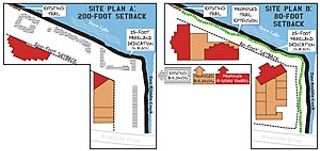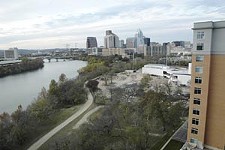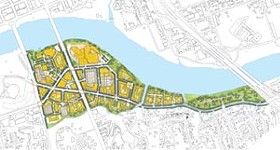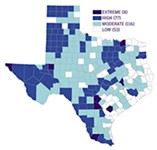The Town Lake Variance Shuffle
The hike-and-bike trail, questionable developer tactics, and a potential windfall for urban parks all flow together on East Riverside Drive
By Katherine Gregor, Fri., Nov. 24, 2006
According to city staff, the developer of the project at 222/300 E. Riverside, CWS Capital Partners, may be legally obligated to provide the city of Austin significantly more parkland than it had planned to, on a prime Town Lake waterfront site. The project – an 838-unit, high-rise residential complex proposed for the south shore of Town Lake – offers a valuable opportunity for the city to extend the Town Lake hike-and-bike trail. Acquiring parkland on the site is a high priority, said assistant director Stuart Strong of the Parks & Recreation Department, in order to help close a gap in the trail and provide a buffer of parkland for trail users.
The questions that have arisen over parkland dedication provisions for this particular project, sited on two pieced-together tracts of adjoining waterfront land, also highlight a loophole in the city's Land Development Code – one that Parks staff hope to correct. If implemented, the code update could provide many millions more annually in developer "impact fees," to fund park projects in close-in neighborhoods and Downtown, such as completing and enhancing the Town Lake Trail.
For the 222 E. Riverside tract, the amount of land that CWS would have to dedicate as parkland was calculated on the existing 100 apartments (1970s three-story structures that CWS plans to tear down), according to David Wahlgren, a senior planner with Watershed Protection and Development Review. (The 300 E. Riverside tract was exempted; more on that below.) The 100-unit figure was contained within a December 2005 subdivision application. But Wahlgren and Parks staff believe that the CWS parkland dedication more equitably should be based on the new 486-unit Riverside Condominiums the company plans to build on the site, for which site plans were submitted to the city this year. Staff expressed irritation that the developer failed to provide the correct 486-unit number in extended discussions with city parks staff about how it would meet its parkland dedication obligation. Based on the new project to be built, the developer's parkland obligation to the city would be almost five times the $462,821 value previously assessed. And if it's not corrected, the developer's apparent underreporting potentially could cheat Austinites out of new waterfront parkland worth millions.
"When we got the site plan, that's when we first realized it," said Parks planner Butch Smith of the disparity. "It would have been nice if they'd just come forward and said, 'This is not correct.'"
The developer's representative, local real estate attorney Richard Suttle Jr., has not returned calls from the Chronicle. However, he indicated by e-mail that he believes no error was made in basing parkland dedication on existing units rather than new ones planned. As Suttle sees it, that standard conforms to the parkland dedication code.
A Shell Game, Not a Gift
The CWS project is garnering community and neighborhood scrutiny as a test case of the city's current commitment to the Town Lake development protections defined by ordinance for the Waterfront Overlay District. (See accompanying article "Close to Outrage," and "A Waterfront War?" Oct. 20, at austinchronicle.com.) The WO District encompasses all land fronting Town Lake, as well as along certain tributary creeks. A chief protection for it is building-setback provisions, which ensure public open space along creeks, Town Lake, and the hike-and-bike trail. While the WO ordinance requires a 200-foot setback on the 222/300 E. Riverside sites, the developer has requested variances to build three 17-story towers just 80 feet from the shoreline. Because this is 120 feet closer than the WO ordinance permits, the project would require significant, precedent-setting variances from the Planning Commission or, if denied there, from City Council.
In an interview some weeks back with the Chronicle and as quoted in the Statesman, Suttle has portrayed his client as making a good-faith gift to the city in agreeing to dedicate waterfront land and to extend the hike-and-bike trail along the shoreline. The "gift" of about an acre of lakefront land by CWS has been publicly represented as a fair trade for the variances requested from the Waterfront Overlay. But the Parks Department's Smith said, "It's not a gift; it's what they owe. If they want to get their project approved, they have to dedicate the land as parkland."
Not only is the developer required to dedicate parkland, but city staff believe that CWS should have offered up more for an 838-unit project that could house well more than 1,500 people – if only as part of a good faith effort, given the ambitious variances being pursued. In fact, Smith said he'd never before seen a developer "misrepresent" its plans for a new development on a site. "I've never run across a case like this before," he said. "This is an odd situation."

View a larger map
Based on the existing 100 units, and the standard parkland dedication formula of 5 acres per 1,000 residents, the city calculated the value of the parkland owed at $462,821. It signed an agreement that CWS would meet its obligation by transferring to the city the title to a 25-foot-wide strip of land along about 1,700 feet of shoreline (about 1,000 feet along Town Lake, plus about 700 feet turning inland along East Bouldin Creek). The agreement also requires the developer to build a 10-foot-wide extension of the hike-and-bike trail on the transferred land. A $463,821 deposit already has been received from the developer; typically the deposit is returned after the developer meets the terms of the agreement.
Which raises the question: Is it too late to go back and assess the full parkland value due?
"A discrepancy of that order would have to be rectified," said PARD's Strong, who has taken an interest in the case. "As they go through the approval process, they'll have to go back and modify that parkland dedication agreement." PARD already has communicated to the developer and its attorney the need to adjust the agreement, said Strong. "Certainly it opens up some other opportunities."
Strong said he would fully brief the Parks Board (scheduled to vote on the project Nov. 28) and the Planning Commission (likely to vote Dec. 12) on the project's parkland dedication issues, before they decide whether to grant the developer's variance requests. On Nov. 14, the land and facilities subcommittee of the Parks Board recommended to the full board a denial of all variances to the Town Lake setback, while permitting setback reductions along East Bouldin Creek.
A Parkland Loophole
As defined by Section 25-4-2-12 of the city's subdivision ordinance, "Dedication of Parkland Required," a developer is legally required to dedicate parkland on its subdivided residential property, if desired by the Parks and Recreation Department. (At its discretion, PARD may instead assess an in-lieu fee.) But the subdivision ordinance was written with the suburbs in mind; it does not apply to most residential high-rises on urban sites, because they typically do not have to be subdivided. Yet Austin is now seeing condo towers as dense as whole subdivisions, with hundreds of units and thousands of residents.
"We are currently reviewing the existing parkland dedication ordinance to refine it, close loopholes, and make it more equitable," said Smith. The solution would be to move the parkland dedication requirement into another part of the Land Development Code, said Strong; the Parks Board has instructed him to put the matter on an upcoming agenda. (According to Parks board member Danette Chimenti, at a recent meeting of the Land & Facilities Subcommittee "even Richard Suttle" agreed that the code inequity should be corrected.)
One couldn't ask for a more dramatic example of the inequity in parkland dedication assessments than the CWS project and its two adjoining tracts. The parkland obligation applied to one side, 222 E. Riverside, because the tract happened to be subdivided. Yet no parkland was due on the adjoining property, 300 E. Riverside, because it previously had received a subdivision waiver. Part of the same project, the latter tract is site-planned for another 252 units – bringing the project total to 838 units. If a parkland assessment had been due equitably on both properties, the developer would have been legally obligated to dedicate parkland worth $3,896,348 – more than eight times the assessment made. This would have funded a far more generous swath of Town Lake parkland than the puny 25 feet already agreed to by the developer. In general, said Strong, PARD always wants more parkland green space to buffer the hike-and-bike trail from urban development – such as the 17-story condo towers that CWS plans to build.
For a few other residential towers requiring dedicated parkland, because they were on subdivided land, the city has assessed a lower in-lieu fee, said Strong, since the acreage formula assumes lower suburban land values. If the parkland dedication requirement is updated, and made to apply to all residential developments, it is likely to include a lower flat-fee option for urban high-rises.
In negotiating, Suttle has represented that his client will not donate the land or build the trail extension (but will instead leave in place some of the existing 1970s apartments, very close to the water) if it doesn't get the variances needed to encroach on the Waterfront Overlay. Previously, Suttle has said CWS was willing to incorporate a Parks police substation or office into the project or perhaps include an educational Parks exhibit on the ground floor.
Whether CWS would be inclined to kill or modify the project if no variances are granted is unknown. Travis County property-tax records show 222 E. Riverside to be valued at $6,626,520 and 300 E. Riverside (before the sale to CWS) valued at $7,760,760 – although a source close to the deal said that CWS paid significantly more. Existing "L" zoning on the site allows the developer to build 200-foot towers; an alternate CWS site plan shows that, without variances, the site still could accommodate a large residential complex with at least two 17-story condo towers. (Existing apartment buildings within the WO setback are shown left in place; however, this seems unlikely given the parkland dedication requirement and other site factors.)
On balance, CWS Capital Partners no longer appears to have offered the city much of real value, beyond its obligations, to earn its development bonuses.
"It's all in play. The talks are not over," said Strong. "What we're testing here is a model – and in Austin, we do have to establish a new model. This is really uncharted territory. But we support the principle of the setback." ![]()
Got something to say on the subject? Send a letter to the editor.











